Shifting sands: why SA pays for an endless cycle of beach replenishment
SPECIAL REPORT: South Australians are paying hundreds of millions of dollars to walk along sandy metropolitan beaches. And we’ll spend hundreds of millions more to keep them. David Eccles explains.

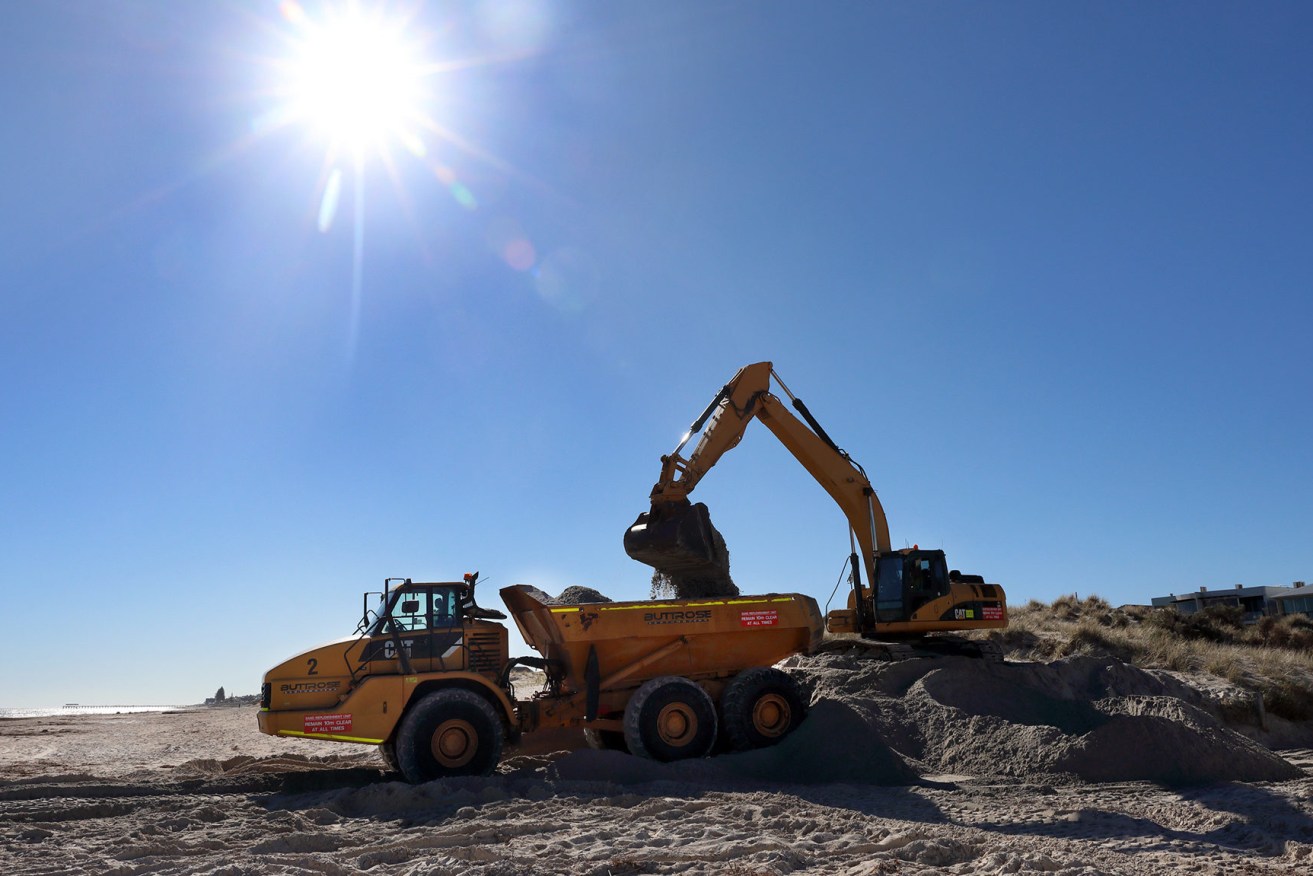
More than five million cubic metres of sand have been moved around Adelaide metropolitan beaches since 1973, with no end in sight. Photo: Tony Lewis/InDaily
What value do you put on being able to stroll barefoot along clean white sand on beaches from Somerton to Semaphore?
The answer: an estimated $145 million from 1973 to July this year, paid out of State Government coffers.
And that 40 per cent hike in the “bin tax” announced in the June 18 budget which outraged councils and forced some to raise rates?
All those millions of dollars are heading down the beach, too.
That money from the solid waste levy is paid directly to the State Government, which allocated $48.4 million from now until 2020-21 for sand replenishment.
The 2019-20 State Budget, Budget Paper 5 explains that $5 million will be spent this and next financial year “for immediate sand carting to halt ongoing loss of sand until external sand and a sand recycling pipeline are delivered”.
Another $15 million has been set aside for a “large external sand delivery”, and $28.4 million for a sand recycling pipeline from Semaphore South to West Beach, with work set to begin in 2021-22, and to be operational by 2023-24.
That brings the estimated total cost so far to nearly $200 million – but it doesn’t stop there. And it will never stop.
When the new pipeline is built, operating it will cost between $5 to $6 million a year, plus $1 million a year to source extra sand to top up the system.
That’s another estimated $70 million in the decade to 2032-33, taking the total figure over the decades to more than a quarter of a billion dollars.
And it’s all spent to move sand. Lots of it.
I try to explain it to people and they don’t believe you.
From 1973 to June 2019, 5.5 million cubic metres of sand have been shifted around metropolitan beaches.
That’s enough to fill 275,000 trucks carrying an average 20 cubic metres each.
It’s big dollars and a big headache, with no relief in sight.
So why do it?
Coast Protection Board chair and former Environment Department CEO Allan Holmes says it’s simple: there is no choice.
Holmes led the Environment Department from 1999 -2014 and has chaired the CPB since 2014.
“Essentially the reason we have a beach system in Adelaide is because we put sand on it, and we’ve moved sand around,” he said.
Without shifting sand, “you wouldn’t have a beach”.
“All the road infrastructure, first line of houses, would be under attack from the sea,’’ he said.
“You would have ended up with a complete coastline of a rock wall, and without adding sand you don’t have a sandy beach – you’d have a clay beach, with water right up to your rock wall.
“That’s the disaster you end up with, if you don’t intervene.”
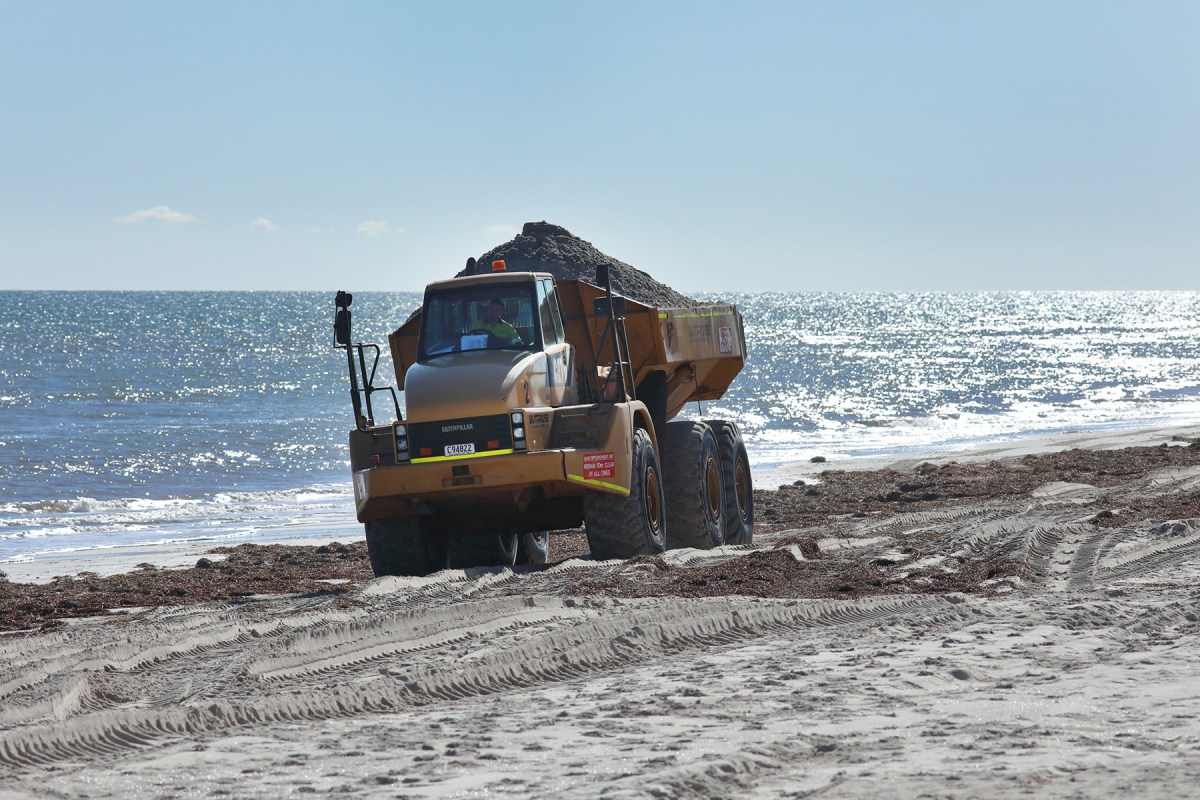
Sandcarting at West Beach this week. Photo: Tony Lewis/InDaily
Holmes provided InDaily with the funding and sand tonnage figures quoted above, from when sand replenishment first began in 1973.
In the 46 years since, 1.5 million cubic metres of coarse “external” sand has been dredged and pumped onshore.
A further 4 million cubic metres has been collected from where sand drifted north to stop at Semaphore, and moved back down south to begin the cycle anew.
Holmes says trucking that sand, at an average $25 a truckload, has so far cost an estimated $100 million, in today’s dollars.
Dredging and pumping 1.5 million cubic metres of sand ashore has cost an average $30 a cubic metre.
Multiplying those figures gives an estimated total of $145 million.
But without that money and effort, most metropolitan beaches – Brighton, Glenelg, West Beach, Henley Beach – would have disappeared years ago.
“It’s a massive intervention,” Holmes said.
“I try to explain it to people and they don’t believe you.”
It’s an endless battle of attrition with nature, without the possibility of ceasefire or victory.
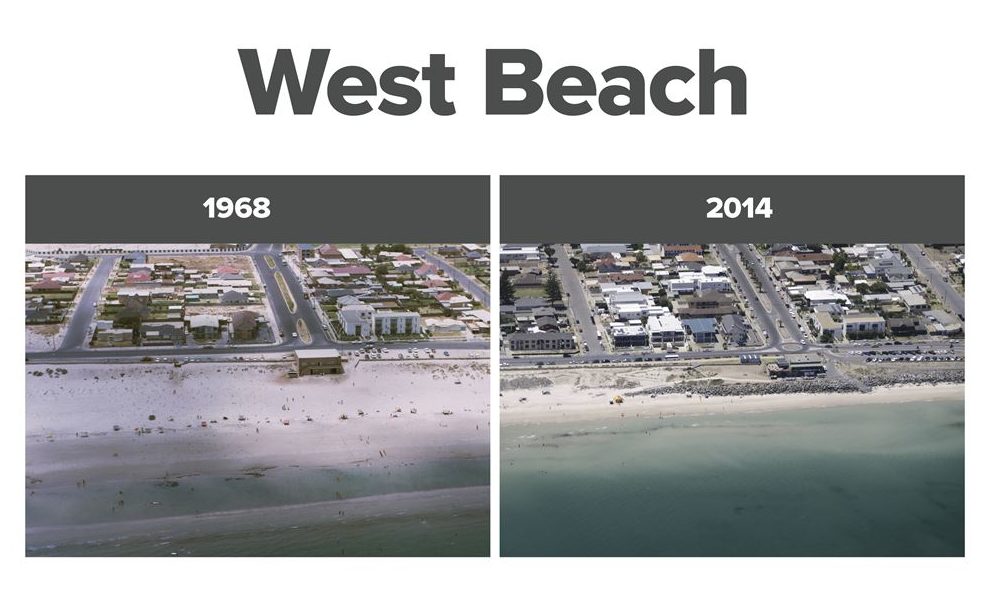
Sand loss at West Beach has prompted renewed effort at shoring up supplies. Photo: Coast Protection Board
The vicious, expensive cycle was set in place more than a century ago, when sand dunes which once lined much of the metropolitan coast were targeted for commercial exploitation and development.
‘We took hundreds of thousands of cubic metres of sand out of the dune system, for construction, for glass manufacture,’” Holmes said.
“We didn’t know what we were doing. And then we built on the dunes, so the sea couldn’t move.”
As roads and housing lined the beachfront, treated effluent – up to 80,000 megalitres a year at its peak– was pumped into the sea, killing an estimated 5000 ha of seagrasses which once acted as underwater dunes by binding a layer of sand near shore.
“That destabilises and deepens the beach, increasing wave energy,” Holmes said.
Adelaide’s coastline became scoured by waves and storms, unable to be replenished by now-absent dunes.
Severe damage to the coast occurred in the 1950s and ’60s, prompting the State Government in 1965 to order a study of the metropolitan beach system.
The Culver Report, as it was known, led to the creation of the Coast Protection Act and Coast Protection Board.
It also marked the beginning, in 1973, of actively redistributing sand from north to south, dune stabilisation and building of engineered sea walls.
Despite all the sand shifting, West Beach lost much more sand than it was being topped up with.
A second review in 1984 found that annual sand replenishment was essential, seawalls were no long-term alternative to sand protection, and that urgent sourcing new sand from outside the beach system was needed.
That’s because, with each journey down the coast, sand becomes finer and moves faster until it is lost and has to be replaced with a fresh supply.
In 1988, 190,000 cubic metres were trucked from Torrens Island and 100,000 cubic metres were dredged at North Haven, pumped ashore and trucked to Somerton Park.
Two years later, another 100,000 cubic meters were collected off North Haven and trucked to Glenelg North, with the first trial dredging at Port Stanvac in 1991 adding another 200,000 cubic metres of sand to beaches.
In 1997 alone, about 600,000 cubic metres of sand was dredged from Port Stanvac and dumped at Brighton, but a year later the source was exhausted, and an exclusion zone near and on the approach to the former refinery jetty locked out access to plentiful sand deposits within.
Small amounts of sand were then trucked from Mt Compass, but for the past 20 years, no major supplies of external sand have been put onto Adelaide beaches – despite expert warnings it was urgently required.
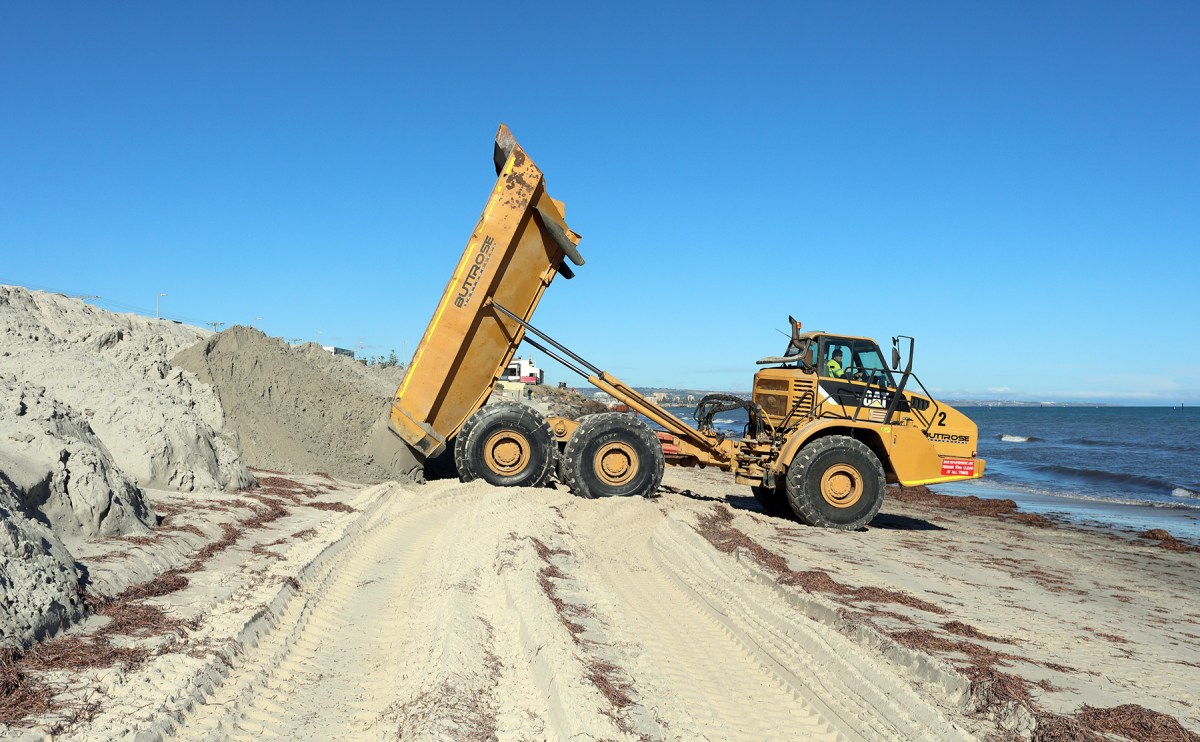
Photo: Tony Lewis/InDaily
Various engineering solutions were considered in that time, including offshore breakwaters, with one proposal to build about 35 groynes placed about 500 metres apart along the coast.
The aim was to create irregular beaches and slow sand movement, but it was acknowledged the scheme would be expensive and ugly, and never proceeded.
Holmes says built solutions have now been discounted as costing too much, requiring lots of sand and being no better than sand pumping.
“Many people will say the simple thing here is to build a structure,” he said.
“The experts tell us that’s not the way to go.”
In 2005, the Adelaide Living Beaches strategy was released, but Holmes said while state governments endorsed the study it only adopted some elements and deferred others – including sourcing external sand.
Meanwhile, existing sand continued to shift, and drift.
In a briefing note written in November last year, Holmes set out how much new sand was required a year, and what happened when the flow was cut off.
“Since 1998 when beach replenishment from external sources effectively stopped, government has been aware sand reserves were being eroded and that at some point this would become critical, and urgent action would be required,” he said.
The metropolitan beach system as a total unit operates almost as a closed system.
“However, some is lost for replenishment purposes each year as unsuitable fine sand at the northern extremity of the metropolitan coast, and around 25,000 cubic metres is needed annually to offset the erosive impact of the current rate of sea-level rise.
“Over a twenty-year period (1998 to 2018) this translates to a net loss of over 500,000 cubic meters of usable sand and explains the problems faced today.”
While shifting sand from areas of buildup in the north back to the south has worked to a point “the Board and the Department have continued to advise that the arrangements were not sustainable in the medium term and that problems would start to emerge”.
And that problem is nowhere clearer than at West Beach.
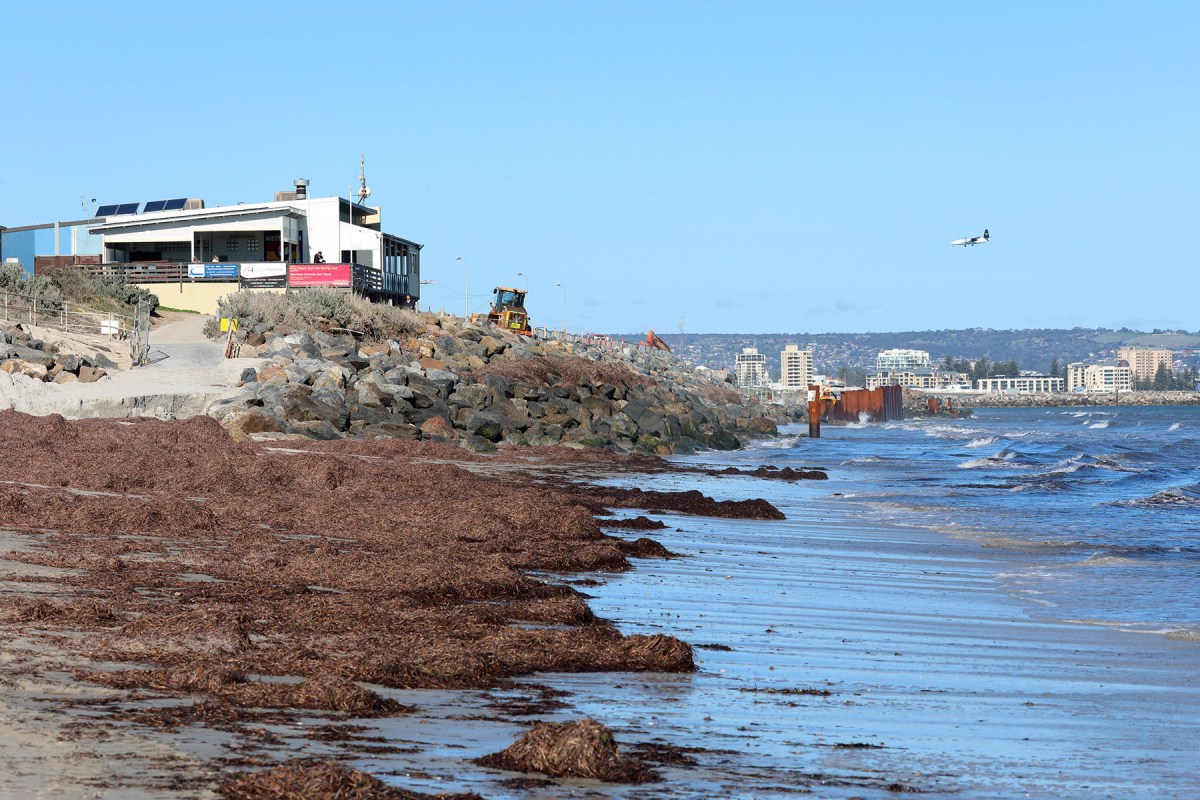
A rock wall protects West Beach Surf Lifesaving Club from the tide. Photo: Tony Lewis/InDaily
There, the once-wide sweep of sand has vanished, despite decades of effort.
Waves lap close to the Surf Lifesaving Club, now protected by a formidable rock wall.
Vast areas of sand are lost to winter storms which strip the beach, leaving staircases ending forlornly in mid-air a metre or more above the ground.
In 2017, a consultant, Danish Hydraulics Institute, was commissioned to examine West Beach – and its results shocked the Environment Department.
It had long estimated the annual loss of sand at West Beach, mostly to northward drift, at about 50,000 cubic metres a year.
In fact, the DHI report revealed it to be between two and three times that amount, or 100,000 to 150,000 cubic metres lost every year, as it drifted north to build up at Semaphore.
Despite all the sand shifting, West Beach lost much more sand than it was being topped up with.
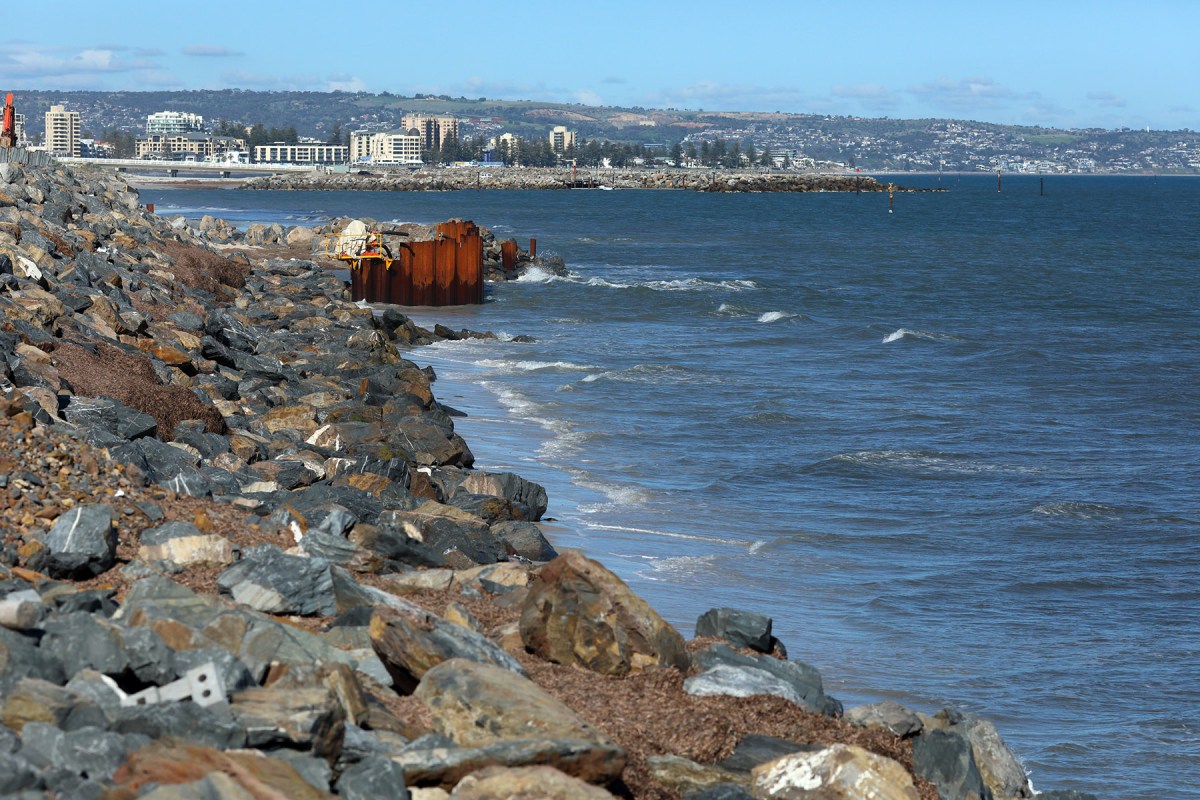
Experts say stopping sand replenishment would lead to rock walls lining the Adelaide metropolitan coast. Photo: Tony Lewis/InDaily
“In essence, the investigation revealed that a net loss of around 60,000 cubic meters per year from the West Beach cell had occurred over recent years,” Holmes said.
“Underlying this local problem is the much bigger issue of net loss of sand from the beach system which expresses itself first at West Beach. The DHI report was based on a model for the whole metropolitan beach which has much broader application than just explaining the West Beach situation.”
Holmes said West Beach was the canary in the coal mine for the Adelaide coast.
“We haven’t added sand to that metropolitan beach system for 20 years,” he said.
“And you lose sand. If you don’t add it, inevitably your beach system will disappear.”
The situation was explained to the new Marshall Government, in terms set out in Holmes’ briefing document.
“Importing of new sand to balance the long-term losses is critical if Adelaide is to retain sandy beaches,” he said.
“Until a new sand source is identified and accessed, considerably more sand will need to be redistributed from within the system to avoid critical shortfalls at specific locations.”
Holmes said the DHI report pulled no punches in putting weight into longstanding calls for action.
“The department and board have been saying to the government for the past four or five years, you really do need to do something about this,” he said.
“It was the international consultants who came to look at the beach in its entirety. They were pretty clear, they laid it on the line.
“They said at West Beach you are finally seeing the impact of not importing sand into the beach system and you are losing it from that cell at a very significant rate.
“You have to pull sand back from the north, and you have to put more sand into the system. That was the guts of the recommendations.
“You have to do something pretty quickly. Once that became clear I don’t think the government had much choice.
“And our view was if you’re going to pull it back from the north, you might as well pump it rather than truck it. And the government bought it.
“Just a real recognition that there was no way out. They had to do it.”
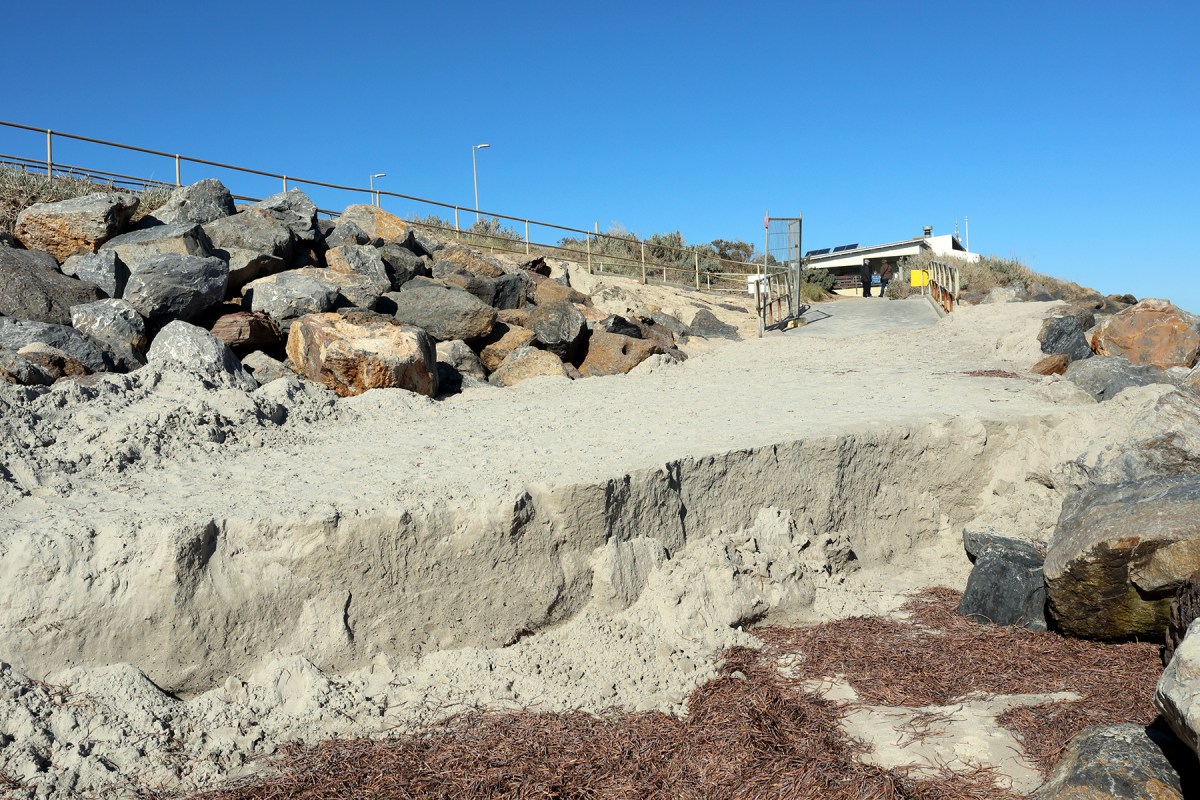
Built up sand at West Beach is continually lost to waves and northwards drift. Photo: Tony Lewis/InDaily
The solution was to continue sand carting, spend $15 million to dredge new sand from the Port Stanvac banks once locked away but now accessible, and to build a new pipeline to pump sand from Semaphore back to West Beach.
The Government listened, and acted, but only revealed its $48.4 million dollar plan when Treasurer Rob Lucas announced it on Budget day three weeks ago.
Lucas and the government did not consult councils, but decided they – and ultimately ratepayers – would fund the immediate beach works required, via a hefty 40 per cent increase in the solid waste levy paid to government to send household waste to landfill.
Some councils now pay more than $600,000 annually and had to hurriedly raise rates by more than expected to cover it.
Holmes said the money had to come from somewhere: “How else could you do it? Yes, it does cause a yike from councils, but you have to pay for it some way.”
While the total spend on sand replenishment over decades added up, it would “pale into insignificance” compared with the cost of maintaining essential infrastructure.
“This is an extraordinary asset – the metropolitan beach is critical to Adelaide,” he said.
“It’s probably the most used recreational facility. It has massive use.
“In the scheme of things, it actually isn’t a huge expenditure item if you put it into the context of maintaining roads or maintaining a port facility. “
But the reality is that even with million of dollars extra funding, pumping and shifting, an estimated 25,000 cubic metres of sand will continue to be lost from the system each year.
Authorities, taxpayers and ratepayers will continue to essentially tread water, on a seemingly endless cycle of sand churning.
“So that’s the rub, if you like,” Holmes said.
“At the end of this project we’ll have a sandy beach, a pumping system which is functional, and every 10 years you’ll have to top it up with 250,000 cubic metres of sand – that’s the ballpark figure.
“I’m of the view, this is the only solution you’ve got. Because if you don’t do that, you’re back to the rock walls and clay beaches.
“It’s just a matter of time.”
Want to comment?
Send us an email, making it clear which story you’re commenting on and including your full name (required for publication) and phone number (only for verification purposes). Please put “Reader views” in the subject.
We’ll publish the best comments in a regular “Reader Views” post. Your comments can be brief, or we can accept up to 350 words, or thereabouts.




